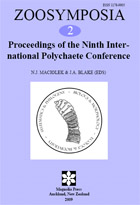Abstract
in Tunisia, polychaete studies are very rare (Fauvel 1924 a, b; Westheide 1972; Zibrowius 1970, 1971; Cantone 1978; Ben Amor 1984; Zaâbi & Afli 2005). The aim of this study was to update and fill in gaps in data of polychaetes of Tunisia. Samples were taken aboard the research vessel R/V Hannibal with a Van Veen grab (0.1 m²) and a core (0.009 m²). Nine sites located on the peninsula of Cap Bon on the NE coast of Tunisia, from Sidi Daoud to Ras Lahmer, were sampled in 2005 and 2006. A total of 5,920 individuals in 29 families and 88 species of polychaetes were identified. Twenty-nine species were newly recorded for Tunisia, including the ampharetid Isolda pulchella O.F. Müller, 1858 and the paraonid Aricidea cerrutii (Laubier, 1966). Diversity parameters were established. Abundance and species richness were higher in shallow waters dominated by Protodorvillea kefersteini (McIntosh, 1869) and Malacoceros fuliginosus (Claparède, 1868) than in deep waters where Aponuphis fauveli (Rioja, 1918) and Euclymene palermitana (Grube, 1840) dominated. Multivariate methods, including the Shannon diversity index, cluster analysis, and rank frequency analysis, were used to characterize the spatial structure and temporal variability of the different communities.

